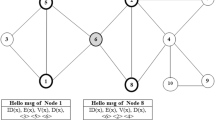Abstract
This paper describes the Connected Dominating Set-Energy Protocol (CDSEP) for mobile ad hoc networks. The key concept used in the protocol is a new algorithm to construct Connected Dominating Set based on Energy and Connectivity (CDSE). This algorithm also permits to calculate the routing table based on the prediction. We propose a distributed algorithm to build a virtual topology based on Energy and Connectivity. This topology is used in the routing process. The nodes which build this topology are chosen according to two parameters: energy and connectivity, these nodes are named diffusion or dominator node. The CDSE virtual topology nodes forward broadcast packets during the flooding process. This technique greatly reduces the control packets and energy consumption as compared to Multipoint Relay flooding mechanism. In CDSEP protocol, the CDSE information is flooded in the network only by CDSE nodes. Thus a second optimization is achieved by minimizing the contents of the control packets flooded in the network. Hence, only a small subset of links is declared instead of all the network links. This information is then used by the CDSEP protocol to construct and predict the route. Simulation results show the CDSEP performances compared to Optimized Link State Routing Protocol for various metrics like overhead, energy consumption, end-to-end delay and packet delivery ratio.
















Similar content being viewed by others
References
Sarkar, S. K., Basavaraju, T. G., & Puttamadappa, C. (2008). Ad hocmobilewireless networks, principles, protocoles, and application (pp. 59–112). Taylor edition.
Theoleyre, F., & Valois, F. (2004). Construction de structures virtuelles dans les réseaux ad hoc. In: Techniques Algorithmiques, Réseaux et d’Optimisation pour les Télécommunications (TAROT), Paris, France.
Perkins, C. E ., & Watson, T. J. (1994). Highly dynamic destination sequenced distance vector routing (DSDV) for mobile computers. ACM SIGCOMM, London, UK.
Murthy, S., & Aceves, J. J. (1995). A routing protocol for packet radio networks. In ACM international conference on mobile computing and networking, Berkeley, CA.
Chen, T. W., & Gerla, M. (1998). Global state routing, a new routing scheme for ad-hoc wireless networks. IEEE ICC, Atlanta, USA.
Clausen, T., & Jacquet, P. (2003). Optimized link state routing protocol (OLSR). RFC 3626, IETF Network Working Group. http://www.ietf.org/rfc/rfc3626.txt.
Clausen, T., Jacquet, P., Laouiti, A., Muhlethaler, P., Qayyum, A., & Viennot,L. (2001). Optimized link state routing for ad hoc networks. IEEE INMIC Pakistan.
Theoleyre, F., & Valois, F. (2006). On the performances of the routing protocols in MANET: Classical versus self-organized approaches. In Networking IFIP, Coimbra, Portugal.
Mills, K. L. (2007). A brief survey of self-organization in wireless sensor networks. Wireless Communications and Mobile Computing, 7(7), 823–834.
Jiang, M., Li, J., & Tay, Y. C. (1999). Cluster based routing protocol (CBRP). Internet Draft, draft-ietf-manet-cbrp-spec-01.txt.
Haggar, B. (2009). Self-stabilizing clustering algorithm for ad hoc networks. Wireless and Mobile Communications, 2009. ICWMC ’09. Fifth international conference, Cannes, La Bocca.
Chun, Y. C., Gen, H. C., & Eric, H. K. W. (2003). A stability aware cluster routing protocol for mobile ad hoc networks. Wireless Communications and Mobile Computing, 3(4), 503–515.
Theoleyre, F., & Valois, F. (2004). A virtual structure for mobility management in hybrid networks. In Wireless Communications and Networking Conference (WCNC), IEEE, Volume 5, Atlanta, USA.
Theoleyre, F., & Valois, F. (2005). Virtual structure routing in ad hoc networks. In International conference in communications (ICC), Vol. 2, IEEE, Seoul, Korea.
Cheng, X., & Du, D. (2002). Virtual backbone-based routing in multihop ad hoc wireless networks. Technical report 02-002, University of Minnesota, Minnesota, USA.
Malpani, N., Welch, J. L., & Vaidya, N. H. (2000). Leader election algorithms for mobile ad hoc networks. In Fourth international workshop on discrete algorithms and methods for mobile computing and communications, Boston, USA.
Benaouda, N., Guyennet, Hervé., Hammad, A., & Mostefai, M. (2010). A new two level hierarchy structuring for node partitionning in ad hoc networks. In SAC’10, 25th ACM symposium on applied computing, Zurich, Switzerland.
Haas, J., & Pearlman, R. (1997). The zone routing protocol (ZRP) for ad hoc networks. Internet Draft, draft-haas-zone-routing-protocol-00.txt, November.
Santi, P. (2005). Topology control in wireless ad hoc and sensor networks (pp. 159–184). Wiley edition.
Rieck, M., Pai, S., & Subhankar, D. (2005). Distributed routing algorithms for wireless ad hoc networks using d-hop connected d-hop dominating sets. Computer Networks, 47, 785–799.
Wu, J., & Li, H. (1999). On calculating connected dominating set for efficient routing in ad hoc wireless networks. The 3rd int’l workshop on discrete algorithms and methods for mobile computing and communication (DIAL’M), Seattle, USA.
Harri, J., Bonnet, C., & Filali, F. (2005). OLSR and MPR: Mutual aependences and performances. Research report RR-05-138, Institut Eurécom Department of Mobile Communications, France.
Kies, A., Maaza, Z. M., & Belbachir, R. (2012). A connected dominating set based on connectivity and energy in mobile ad hoc networks. Acta Polytechnica Hungarica, 9(5), 139–154.
Fall, K., & Varadhan, K. (2008). The ns manual. The VINT project. A collaboration between researchers at UC Berkeley, LBL, USC/ISI, and Xerox PARC, November 8.
Acknowledgments
This work is part of the CAPRAH project 08/U311/4966, supported by the Algerian Ministry of Higher Education and Scientific Research.
Author information
Authors and Affiliations
Corresponding author
Rights and permissions
About this article
Cite this article
Kies, A., Maaza, Z.M., Belbachir, R. et al. Routing Protocol Based on CDSE Virtual Topology in Ad Hoc Network. Wireless Pers Commun 80, 923–945 (2015). https://doi.org/10.1007/s11277-014-2063-x
Published:
Issue Date:
DOI: https://doi.org/10.1007/s11277-014-2063-x




